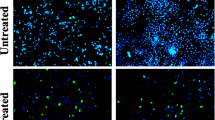Natural phenolic compounds have inhibition effects on various malignancies. Thymol is one of these compounds present in several plant sources such as ajowan (Trachyspermum ammi) fruits. In this study, thymol was evaluated for its potential cytotoxic activity as well as its effect on apoptotic gene expression in breast cancer cell line. We used the GC-MS technique to identify the essential oil constituents of ajowan. MCF-7 cells were treated by various concentrations of thymol and half maximum inhibitory concentration (IC50) was evaluated by 3-(4,5-dimethylthiazol-2-yl)-2,5-diphenyltetrazolium bromide assay. In addition, morphological alterations and changes of P21, P53 and Mcl-1 gene expression in MCF-7 cells were investigated by microscopic examination and real-time RT-PCR assay. Data from MTT assay indicated that the IC50 values of thymol on MCF-7 cells for 48 h and 72 h were 54 and 62 μg/mL, respectively. Furthermore, this compound significantly affected gene expressions of P53 and P21, but not Mcl-1. Thymol can induce the apoptosis process in MCF-7, and hence it can be considered an anticancer agent in the future.




Similar content being viewed by others
References
C. E. DeSantis, J. Ma, A. Goding Sauer, et al., CA. Cancer J. Clin., 67, 439 (2017).
N. T. Telang, G. Li, M. Katdare, et al., Oncol. Lett., 13, 2477 (2017).
L. S. Aldaghi, H. R. Seresht, and H. Cheshomi, J. Sabzevar Univ. Med. Sci., 23, 353 (2016).
W. Tan, J. Lu, M. Huang, et al., Chin. Med., 6, 27 (2011).
K. Hostanska, G. Jürgenliemk, G. Abel, et al., Cancer Detect. Prev., 31, 129 (2007).
J.-Q. Yu, Y. Yin, J.-C. Lei, et al., Cancer Epidemiol., 36, e40 (2012).
S. I. Balbaa, S. H. Hilal, and M. Y. Haggag, Planta Med., 23, 312 (1973).
B. Ranjan, S. Manmohan, S. R. Singh, and R. B. Singh, Pharma Res., 5, 247 (2011).
A. Mohagheghzadeh, P. Faridi, and Y. Ghasemi, Food Chem., 100, 1217 (2007).
A. A. Qureshi and K. K. Eswar, Plant Arch., 10, 955 (2010).
S. N. Garg and S. Kumar, Fitoterapia, 69, 511 (1998).
T. Ishikawa, Y. Sega, and J. Kitajima, Chem. Pharm. Bull., 49, 840 (2001).
M. M. Zarshenas, S. M. Samani, P. Petramfar, and M. Moein, Pharmacogn. Res., 6, 62 (2014).
A. Özkan and A. Erdoðan, Turkish J. Biol., 35, 735 (2011).
A. Stammati, P. Bonsi, F. Zucco, et al., Food Chem. Toxicol., 37, 813 (1999).
D. Slamenova, E. Horvathova, M. Sramkova, and L. Marsalkova, Neoplasma, 54, 108 (2007).
A. Jaafari, H. A. Mouse, E. M. Rakib, et al., Rev. Bras. Farmacogn., 17, 477 (2007).
S. R. Gedara, Mansoura J. Pharm. Sci., 24, 133 (2008).
C. Hirobe, Z.-S. Qiao, K. Takeya, and H. Itokawa, Nat. Med., 52, 74 (1998).
D. Hanahan and R. A. Weinberg, CrossRef PubMed Google Scholar (n.d.).
S. K. Singh, S. Banerjee, E. P. Acosta, et al., Oncotarget, 8, 17216 (2017).
G. Pistritto, D. Trisciuoglio, C. Ceci, et al., Aging (Albany NY), 8, 603 (2016).
A. Brehm, E. A. Miska, D. J. McCance, et al., Nature, 391, 597 (1998).
H. Hermeking, C. Lengauer, K. Polyak, et al., Mol. Cell, 1, 3 (1997).
Y. Wang, T. Romigh, X. He, et al., Hum. Mol. Genet., 19, 4319 (2010).
Y. Xiao, P. Nimmer, G. S. Sheppard, et al., Mol. Cancer Ther., 14(8), 183 (2015).
H. Cheshomi, L. S. Aldaghi, and H. R. Seresht, J. Biomed, 1, e6623 (2016).
T.-M. Li, G.-W. Chen, C.-C. Su, et al., Anticancer Res., 25, 971 (2005).
A. Ozkan and A. Erdogan, Nat. Prod. Commun., 7, 1557 (2012).
D. D. Deb, G. Parimala, S. S. Devi, and T. Chakraborty, Chem. Biol. Interact., 193, 97 (2011).
R. M. Abed, Al-Mustansiriyah J. Sci., 22, 41 (2011).
Y. Li, J. Wen, C. Du, et al., Biochem. Biophys. Res. Commun., 491, 530 (2017).
E. Aydýn, H. Turkez, S. Tasdemir, and F. Hacýmuftuoglu, Cent. Nerv. Syst. Agents Med. Chem. (Formerly: Curr. Med. Chem. Nerv. Syst. Agents), 17, 116 (2017).
M. Llana-Ruiz-Cabello, D. Gutiérrez-Praena, S. Pichardo, et al., Food Chem. Toxicol., 64, 281 (2014).
Z. Han, W. Wei, S. Dunaway, et al., J. Biol. Chem., 277, 17154 (2002).
B.-D. Chang, M. E. Swift, M. Shen, et al., Proc. Natl. Acad. Sci., 99, 389 (2002).
H. Gali-Muhtasib, R. Hmadi, M. Kareh, et al., Apoptosis, 20, 1531 (2015).
O. Gholami, M. Jeddi-Tehrani, M. Iranshahi, et al., Iran. J. Pharm. Res., 13, 1387 (2014).
Z. Kafi, H. Cheshomi, and O. Gholami, Dose-Response, 16, 1559325818796014 (2018).
T. Abbas and A. Dutta, Nat. Rev. Cancer, 9, 400 (2009).
O. Coqueret, Trends Cell Biol., 13, 65 (2003).
L. Esposito, P. Indovina, F. Magnotti, et al., Curr. Pharm. Des., 19, 5327 (2013).
Acknowledgements
We gratefully acknowledge the contribution of Sabzevar University of Medical Sciences to provide this wonderful opportunity and good facilities to carry out this study.
Conflict of Interest
The authors declare no conflict of interest.
Author information
Authors and Affiliations
Corresponding author
Rights and permissions
About this article
Cite this article
Seresht, H.R., Albadry, B.J., Al-mosawi, A.K.M. et al. The Cytotoxic Effects of Thymol as the Major Component of Trachyspermum ammi on Breast Cancer (MCF-7) Cells. Pharm Chem J 53, 101–107 (2019). https://doi.org/10.1007/s11094-019-01961-w
Received:
Published:
Issue Date:
DOI: https://doi.org/10.1007/s11094-019-01961-w




